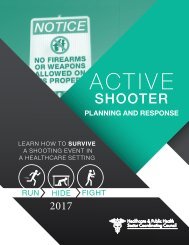ACTIVE
2017_Active_Shooter_Planning_and_Response_in_a_Healthcare_Setting
2017_Active_Shooter_Planning_and_Response_in_a_Healthcare_Setting
You also want an ePaper? Increase the reach of your titles
YUMPU automatically turns print PDFs into web optimized ePapers that Google loves.
Introduction<br />
Welcome to the third edition of Active Shooter Planning and Response in a Healthcare Setting.<br />
When our project began in 2013, we knew that while there were resources to address a public<br />
active shooter event, there was no guidance to address an active shooter event that occurs<br />
inside a healthcare facility. We gathered experts from the public and private sector, and<br />
discussed and debated the difficult questions of patient, visitor, and personal safety, duty to<br />
act, and abandonment. We also committed to regular updates of this guidance, to incorporate<br />
lessons learned, new tactics, and feedback.<br />
This new edition brings additional information on warm zone operations (providing care in an<br />
area wherein a potential threat exists, but it is not direct or immediate, law enforcement<br />
tactics, unified command, and psychological support.<br />
This guidance was produced and updated by the Healthcare and Public Health (HPH) Sector<br />
Coordinating Council (SCC). The HPH Sector Critical Infrastructure Protection (CIP) Partnership<br />
brings together leaders in business and government to prepare for and protect against all<br />
hazards facing the Sector. The CIP framework focuses on protecting HPH organizations<br />
themselves during a disaster, so that they may focus on their mission of saving lives. The<br />
partnership identifies and prioritizes the most critical elements of the Nation's HPH<br />
infrastructure, shares information on risks facing that infrastructure, and implements activities<br />
to protect the Sector. The HPH Sector partnership consists of a Government Coordinating<br />
Council (GCC) of government partners and the SCC of private sector partners. These two groups<br />
come together through two joint working groups and six subsectors to address issues of mutual<br />
concern. All public and private sector members of the HPH Sector with a role in the HPH<br />
Sector’s homeland security mission are invited to take part in one or more of the joint working<br />
groups. More information is available at: http://www.dhs.gov/critical-infrastructure-sectorpartnerships<br />
Active shooter events in a healthcare setting present unique challenges: a potentially large<br />
vulnerable patient population, hazardous materials (including infectious disease), locked units,<br />
special challenges (such as weapons and Magnetic Resonance Imaging (MRI) machines (these<br />
machines contain large magnets which can cause issues with firearms, or remove it from the<br />
hands of law enforcement), as well as caregivers who can respond to treat victims.<br />
There is no single method to respond to an incident, but prior planning will allow you and your<br />
staff to choose the best option during an active shooter situation, with the goal of maximizing<br />
lives saved. The best way to save lives is to remove potential targets from the shooter’s vicinity.<br />
We address some difficult choices that will need to be made in this document.<br />
Page | 3



